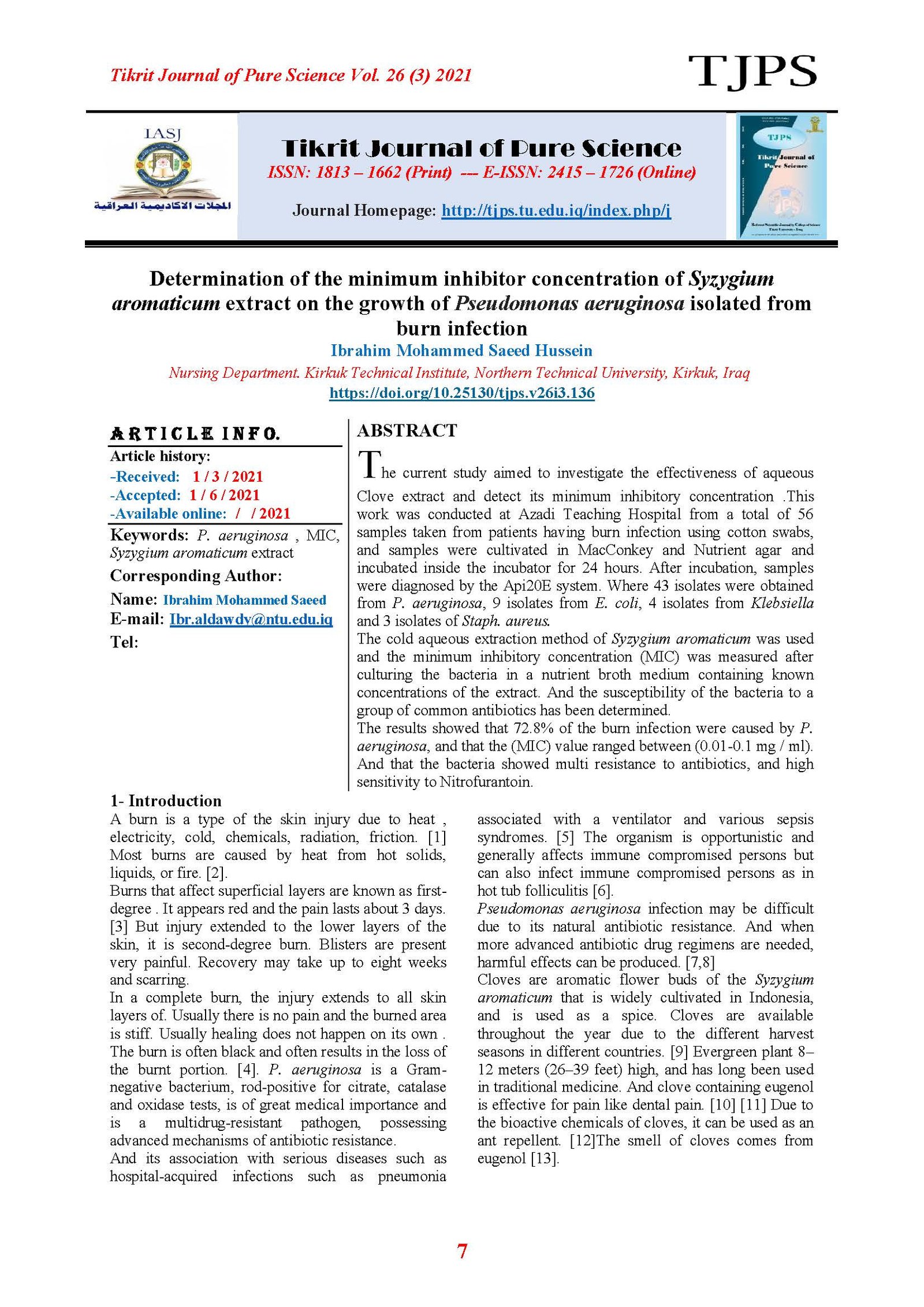Determination of the minimum inhibitor concentration of Syzygium aromaticum extract on the growth of Pseudomonas aeruginosa isolated from burn infection
Main Article Content
Abstract
The cold aqueous extraction method of Syzygium aromaticum was used and the minimum inhibitory concentration (MIC) was measured after culturing the bacteria in a nutrient broth medium containing known concentrations of the extract. And the susceptibility of the bacteria to a group of common antibiotics has been determined.
The results showed that 72.8% of the burn infection were caused by P. aeruginosa, and that the (MIC) value ranged between (0.01-0.1 mg / ml). And that the bacteria showed multi resistance to antibiotics, and high sensitivity to Nitrofurantoin.
Article Details

This work is licensed under a Creative Commons Attribution 4.0 International License.
Tikrit Journal of Pure Science is licensed under the Creative Commons Attribution 4.0 International License, which allows users to copy, create extracts, abstracts, and new works from the article, alter and revise the article, and make commercial use of the article (including reuse and/or resale of the article by commercial entities), provided the user gives appropriate credit (with a link to the formal publication through the relevant DOI), provides a link to the license, indicates if changes were made, and the licensor is not represented as endorsing the use made of the work. The authors hold the copyright for their published work on the Tikrit J. Pure Sci. website, while Tikrit J. Pure Sci. is responsible for appreciate citation of their work, which is released under CC-BY-4.0, enabling the unrestricted use, distribution, and reproduction of an article in any medium, provided that the original work is properly cited.
References
[1] Herndon D, ed. (2012). Chapter 4: Prevention of Burn Injuries. Total burn care (4th ed.). Edinburgh: Saunders. p. 46. ISBN 978-1-4377-27869. [2] Ferri, Fred F. (2012). Ferri's netter patient advisor (2nd ed.). Philadelphia, PA: Saunders. p 235. ISBN 9781455728268. [3] Tintinalli, Judith E. (2010). Emergency Medicine: A Comprehensive Study Guide (Emergency Medicine (Tintinalli)). New York: McGraw-Hill Companies. pp. 1374–1386. ISBN 978-0-07-148480-0. [4] Herndon D, ed. (2012). Chapter 1: A Brief History of Acute Burn Care Management. Total burn care (4th ed.). Edinburgh: Saunders. p. 1. ISBN 978-1-4377-2786-9. [5] Diggle S, Whiteley, M (2020). Microbe Profile: Pseudomonas aeruginosa:opportunistic pathogen and lab rat . Microbiology. 166:pp 30–33. doi:10.1099/mic.0.000860. PMID 31597590. [6[ Gerard, Funke, Case (2016). Microbiology: An Introduction (12th ed.). Pearson Education. p. 54. ISBN 978-0-321-92915-0. [7] Hassett DJ (December 1996). Anaerobic production of alginate by Pseudomonas aeruginosa: alginate restricts diffusion of oxygen. Journal of Bacteriology. 178 (24):pp 7322–5. doi:10.1128/jb.178.24.7322-7325.1996.PMC 178651 PMID 8955420. [8] Worlitzsch D, Tarran R, Ulrich M, Schwab U, Cekici A, Meyer KC, et al. (February 2002). "Effects of reduced mucus oxygen concentration in airway Pseudomonas infections of cystic fibrosis patients". The Journal of Clinical Investigation. 109 (3):pp 317–325. doi:10.1172/JCI13870. PMC 150856. PMID 11827991. [9] "Get Rid of Ants 24". getridofanst24. Archived from the original on 2015-04-28. [10] Kamatou, G. P.; Vermaak, I.; Viljoen, A. M. (2012). Eugenol--from the remote Maluku Islands to the international market place: a review of a remarkable and versatile molecule. Molecules. 17 (6): 6953–6959. doi:10.3390/molecules17066953. PMC 6268661. PMID 22728369. [11] "Eugenol". Pub Chem, US National Library of Medicine. 2 November 2019. Retrieved 10 November 2019. [12] Naqvi SZA; et al (2014). Burn wound infection; significance of rule of nine in microbial surveillance. Professional Mid J 2014;21(5): 869-873. [13] Li-Ming Bao, Eerdunbayaer; Nozaki, Akiko; Takahashi, Eizo; Okamoto, Keinosuke; Ito, Hideyuki; Hatano, Tsutomu (2012). "Hydrolysable Tannins Isolated from Syzygium aromaticum: Structure of a New C-Glucosidic Ellagitannin and Spectral Features of Tannins with a Tergalloyl Group". Heterocycles. 85 (2):365–381. doi: 10.3987/ COM-11-12392. [14] Levinson, W. (2010). Review of Medical Microbiology and Immunology .11th ed.: 94–99. [15] NAIN. (2012). National Antimicrobial Information Network: Benzalkonium Chloride (Alkldimethyl benzyl ammonium chloride) Technical Fast Sheet. [16] Brown, A. E. (2007). Benson`s Microbiological Applications Laboratory Manual in General Microbiology. 10thed. McGraw- Hill comp. Inc. USA. 102-263. [17] NCCLS. (2016). National Committee for Clinical Laboratory Standards Performance for Antimicrobic Susceptibility Testing.
